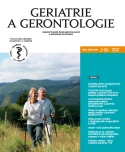Specifics of acute urological care in elderly patients
Authors:
J. Špaček; P. Navrátil jr.; M. Broďák
Authors‘ workplace:
Urologická klinika, FN Hradec Králové
Published in:
Geriatrie a Gerontologie 2019, 8, č. 2: 43-47
Category:
Original Article
Overview
Contemporary urology is developing in the direction of minimally invasive surgery, using modern medication and providing healthcare for men and women of all ages. However, the question is whether it is up to date with demographic trends of the present time. Nowadays, but especially in the coming years, the urologists will be gradually confronted with the increasing numbers of the aging population. This implies the need for a partial reorientation of urology. However, this trend needs to be reflected in the entire health system, including healthcare insurance companies. In elderly patients, the majority of the care is focused on the tumours of the upper and lower urinary tract with the leading role of prostate cancer in men. In cases of a benign diagnosis, it is worth mentioning, that urologists provide diagnosis and treatment of lower urinary symptoms, overactive bladder, incontinence, urinary tract infections, urolithiasis, and erectile dysfunction. All these diagnoses are separate units, they are given a symposium, and their issues are updated in the guidelines. As well as paediatric urology has its position, a new branch of urology focused on a geriatric patient will be probably formed.
Keywords:
Urology – acute care
Sources
1. Křesťanová J. Proměny věkového složení obyvatelstva ČR –2001–2050. Český statistický úřad 2019; https://www.czso.cz/csu/czso/promeny-vekoveho-slozeni-obyvatelstva-cr-2001-2050.
2. Špaček J. Vývodný močový systém a gynekologické malignity. Klinická onkologie 2018; 31(6).
3. Johansen TEB, Botto H, Cek M, et al. Critical review of current definitions of urinary tract infections and proposal of an EAU/ESIU classification system. International journal of antimicrobial agents 2011; 38: 64–70.
4. Ackermann RJ, Monroe PW. Bacteremic urinary tract infection in older people. Journal of the American Geriatrics Society 1996; 44(8): 927–933.
5. Maki DG, Tambyah PA. Engineering out the risk for infection with urinary catheters. Emerging infectious diseases 2001; 7(2): 342.
6. Group ES. EPISEPSIS: A reappraisal of the epidemiology and outcome of severe sepsis in French intensive care units. Intensive care medicine 2004; 30(4): 580–588.
7. Rychlík I. Pacient s hematurií. Interní medicína pro praxi. 2009; 10(10): 440–443.
8. Woolhandler S, Pels RJ, Bor DH, Himmelstein DU, Lawrence RS. Dipstick urinalysis screening of asymptomatic adults for urinary tract disorders: I. Hematuria and proteinuria. Jama 1989; 262(9): 1214–1219.
9. Choong S, Walkden M, Kirby R. The management of intractable haematuria. BJU international 2000; 86(9): 951–959.
10. Pacovský J, Košina J, Holub L, Hušek P, Broďák M. Akutní selhání ledvin. Urology for Practice 2016; 17(2): 75–78.
11. Lindeman RD. Overview: renal physiology and pathophysiology of aging. American Journal of Kidney Diseases 1990; 16(4): 275–282.
12. Abdel-Kader K, Palevsky P. Acute kidney injury in the elderly. Clinics in geriatric medicine 2009; 25(3): 331.
13. Gentric A, Cledes J. Immediate and long-term prognosis in acute renal failure in the elderly. Nephrology Dialysis Transplantation 1991; 6(2): 86–90.
14. Broďák M, Holub L, Košina J, et al. Prevalence symptomů dolních močových cest a hyperaktivního močového měchýře u žen a mužů v běžné populaci. Urolog pro Praxi 2008; 9(1): 16–20.
15. Fitzpatrick JM, Desgrandchamps F, Adjali K, et al. Management of acute urinary retention: a worldwide survey of 6074 men with benign prostatic hyperplasia. BJU international 2012; 109(1): 88–95.
16. Armitage JN, Sibanda N, Cathcart PJ, Emberton M, van der Meulen JH. Mortality in men admitted to hospital with acute urinary retention: database analysis. BMJ 2007; 335(7631): 1199–1202.
Labels
Geriatrics General practitioner for adults Orthopaedic prostheticsArticle was published in
Geriatrics and Gerontology

2019 Issue 2
Most read in this issue
- Risk and complications of the robotic partial nephrectomy in patients in age over 65 years
- The treatment of the water and electrolyte disturbances in geriatric patients.
- TRUS/MRI fusion prostate biopsy in patient over 65 years – results and complication rate analysis.
- Are robot-assisted radical prostatectomies safe in patients over 65?
